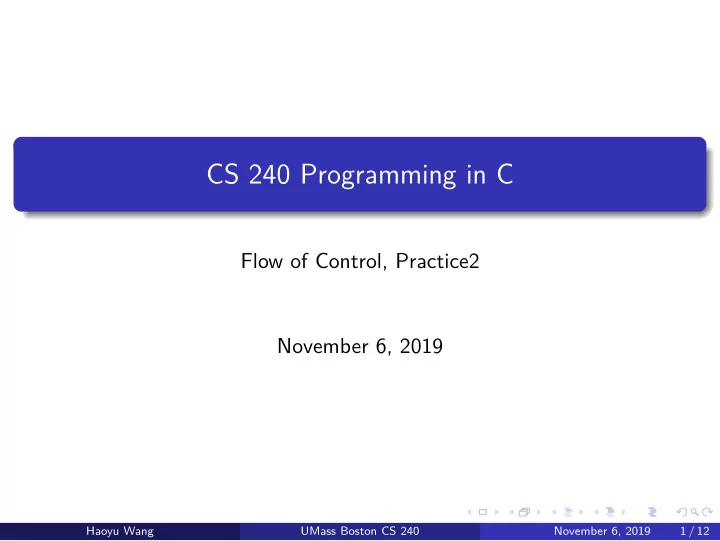

CS 240 Programming in C Flow of Control, Practice2 November 6, 2019 Haoyu Wang UMass Boston CS 240 November 6, 2019 1 / 12
Statements and Blocks Recall that an expression is a combination of values, constants, variables, operators, and functions that evaluates to another value An expression becomes a statement when it is followed by a semicolon For example, x = 0; Curly braces are used to group declarations and statements into a compound statement, or block { x = 0; y = 1; } Note that the closing brace is not followed by a semicolon Syntactically, the grouped statements are equivalent to a single statement Haoyu Wang UMass Boston CS 240 November 6, 2019 2 / 12
If Statements Things to note: The if condition is just testing a numeric value We can use a shortcut in this test: if (expression) same as if (expression != 0) if (!expression) same as if (expression == 0) Haoyu Wang UMass Boston CS 240 November 6, 2019 3 / 12
Else-If Things to note: Can have as many as you want They are evaluated in order If the condition evaluates to true for one, its statement is executed, and we don’t look at the rest An else at the end is equivalent to "none of the above" Haoyu Wang UMass Boston CS 240 November 6, 2019 4 / 12
Switch Statements Another way to do multi-way decisions switch (expression) { case constant-expr1: statements case constant-expr2: statements default: statements } This will test whether expression matches each of the constant expressions and execute the corresponding statements if so The constant expressions must be integer-valued Execution will fall through a switch (which means goes to the next switch statement) unless you add break after statements. That is to day an end of one case statement is not an end of one switch unless it is the last case statement. Haoyu Wang UMass Boston CS 240 November 6, 2019 5 / 12
Counting Digits and White Spaces int main(void) { int c, i, cntWhite, cntOther, cntDigit[10]; cntWhite = cntOther = 0; for (i = 0; i < 10; i++) cntDigit[i] = 0; while ((c = getchar()) != EOF) { switch (c) { case ’0’: case ’1’: case ’2’: case ’3’: case ’4’: case ’5’: case ’6’: case ’7’: case ’8’: case ’9’: cntDigit[c - ’0’]++; break; case ’ ’: case ’\n’: case ’\t’: cntWhite++; break; default: cntOther++; break; } } printf("digits ="); for (i = 0; i < 10; i++) printf(" %d", cntDigit[i]); printf(", white space = %d, other = %d\n", cntWhite, cntOther); return 0; } Haoyu Wang UMass Boston CS 240 November 6, 2019 6 / 12
If-Else vs. Switch Suppose we need to test the value of a status variable, and there are 20 different values With if-else , we test (status == 1) , then (status == 2) , etc. By the time we reach 20, we have tested 19 times With switch , it is usually compiled into assembly as a jump table An array of goto instructions subscripted by the value of status If status is 20, we look up the goto at address 20 in the table This way we only execute that one goto Good practice is to always use break Falling through can be useful, but you should be careful with it as it may create unintended behavior if the program is modified later Haoyu Wang UMass Boston CS 240 November 6, 2019 7 / 12
Loops These are equivalent expr1; while (expr2) { for (expr1; expr2; expr3) statement; statement; expr3; } Note that any part of a for loop can be left out for(init; loop-test; increment) If init is left out, you must initialize somehow If increment is left out, you must manage increment If loop-test is left out, you must break Haoyu Wang UMass Boston CS 240 November 6, 2019 8 / 12
Comma Operator Most often use is in the for-loop statements Pairs of expressions separated by a comma , are evaluated left-to-right Value of comma expression is the value of the rightmost comma-separated expression Example of using the comma operator in a for-loop: rev = (char *)malloc(sizeof(char) * (strlen(str) + 1)); for(i = 0, j = strlen(str) - 1; i < strlen(str); i++, j--) rev[i] = str[j]; rev[i] = ’\0’; Haoyu Wang UMass Boston CS 240 November 6, 2019 9 / 12
Do While do { statements; } while (expression); Guaranteed to execute the statements at least once, regardless of whether expression is true or false Used infrequently Haoyu Wang UMass Boston CS 240 November 6, 2019 10 / 12
Break and Continue break Allows departure from a loop Can be used in for, while, and do loops (similar to its use in switch) Allows you to exit the current loop one level only; remember this when you use break in nested loops continue Skips to the next iteration of the loop It is used to selectively execute statements in a loop iteration Haoyu Wang UMass Boston CS 240 November 6, 2019 11 / 12
Trim Trailing Blanks, Tabs, Newlines #include <string.h> int trim(char str[]) { int n; for(n = strlen(str) - 1; n >= 0; n--) if (str[n] != ’ ’ && str[n] != ’\t’ && str[n] != ’\n’) break; str[n + 1] = ’\0’; return n; } Haoyu Wang UMass Boston CS 240 November 6, 2019 12 / 12
Recommend
More recommend